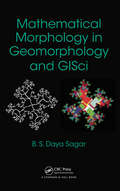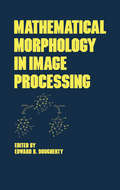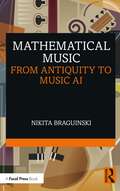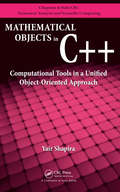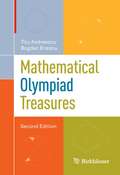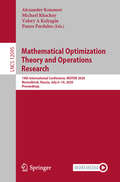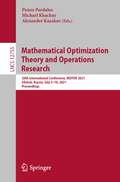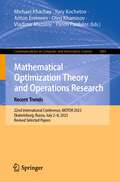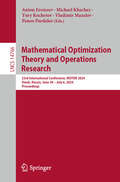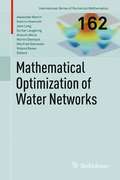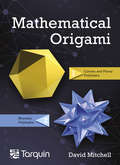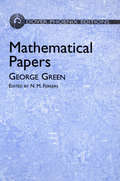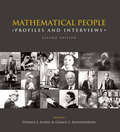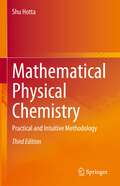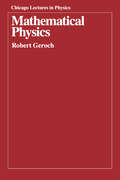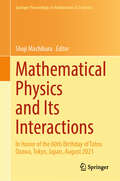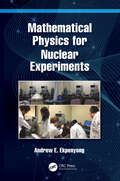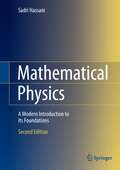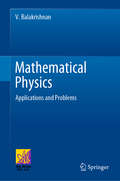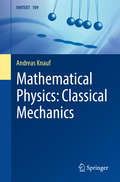- Table View
- List View
Mathematical Models with Applications
by Ralph Bertelle Judith Bloch Roy CameronNIMAC-sourced textbook
Mathematical Models with Singularities
by Pedro J. TorresThe book aims to provide an unifying view of a variety (a 'zoo') of mathematical models with some kind of singular nonlinearity, in the sense that it becomes infinite when the state variable approaches a certain point. Up to 11 different concrete models are analyzed in separate chapters. Each chapter starts with a discussion of the basic model and its physical significance. Then the main results and typical proofs are outlined, followed by open problems. Each chapter is closed by a suitable list of references. The book may serve as a guide for researchers interested in the modelling of real world processes.
Mathematical Morphology in Geomorphology and GISci
by Behara Seshadri Daya SagarMathematical Morphology in Geomorphology and GISci presents a multitude of mathematical morphological approaches for processing and analyzing digital images in quantitative geomorphology and geographic information science (GISci). Covering many interdisciplinary applications, the book explains how to use mathematical morphology not only to perform
Mathematical Morphology in Image Processing (Optical Science and Engineering #1)
by Edward DoughertyPresents the statistical analysis of morphological filters and their automatic optical design, the development of morphological features for image signatures, and the design of efficient morphological algorithms. Extends the morphological paradigm to include other branches of science and mathematics.;This book is designed to be of interest to optical, electrical and electronics, and electro-optic engineers, including image processing, signal processing, machine vision, and computer vision engineers, applied mathematicians, image analysts and scientists and graduate-level students in image processing and mathematical morphology courses.
Mathematical Music: From Antiquity to Music AI
by Nikita BraguinskiMathematical Music offers a concise and easily accessible history of how mathematics was used to create music. The story presented in this short, engaging volume ranges from ratios in antiquity to random combinations in the 17th century, 20th-century statistics, and contemporary artificial intelligence. This book provides a fascinating panorama of the gradual mechanization of thought processes involved in the creation of music. How did Baroque authors envision a composition system based on combinatorics? What was it like to create musical algorithms at the beginning of the 20th century, before the computer became a reality? And how does this all explain today’s use of artificial intelligence and machine learning in music? In addition to discussing the history and the present state of mathematical music, Braguinski also takes a look at what possibilities the near future of music AI might hold for listeners, musicians, and the society. Grounded in research findings from musicology and the history of technology, and written for the non-specialist general audience, this book helps both student and professional readers to make sense of today’s music AI by situating it in a continuous historical context.
Mathematical Objects in C++: Computational Tools in A Unified Object-Oriented Approach (Chapman & Hall/CRC Numerical Analysis and Scientific Computing Series)
by Yair ShapiraEmphasizing the connection between mathematical objects and their practical C++ implementation, this book provides a comprehensive introduction to both the theory behind the objects and the C and C++ programming. Object-oriented implementation of three-dimensional meshes facilitates understanding of their mathematical nature. Requiring no prerequis
Mathematical Olympiad Treasures
by Titu Andreescu Bogdan EnescuMathematical Olympiad Treasures aims at building a bridge between ordinary high school exercises and more sophisticated, intricate and abstract concepts in undergraduate mathematics. The book contains a stimulating collection of problems in the subjects of algebra, geometry, trigonometry, number theory and combinatorics. While it may be considered a sequel to "Mathematical Olympiad Challenges," the focus is on engaging a wider audience to apply techniques and strategies to real-world problems. Throughout the book students are encouraged to express their ideas, conjectures, and conclusions in writing. The goal is to help readers develop a host of new mathematical tools that will be useful beyond the classroom and in a number of disciplines.
Mathematical Optics: Classical, Quantum, and Computational Methods
by Vasudevan Lakshminarayanan Maria L. Calvo Tatiana AlievaGoing beyond standard introductory texts, Mathematical Optics: Classical, Quantum, and Computational Methods brings together many new mathematical techniques from optical science and engineering research. Profusely illustrated, the book makes the material accessible to students and newcomers to the field. Divided into six parts, the text presents state-of-the-art mathematical methods and applications in classical optics, quantum optics, and image processing. Part I describes the use of phase space concepts to characterize optical beams and the application of dynamic programming in optical waveguides. Part II explores solutions to paraxial, linear, and nonlinear wave equations. Part III discusses cutting-edge areas in transformation optics (such as invisibility cloaks) and computational plasmonics. Part IV uses Lorentz groups, dihedral group symmetry, Lie algebras, and Liouville space to analyze problems in polarization, ray optics, visual optics, and quantum optics. Part V examines the role of coherence functions in modern laser physics and explains how to apply quantum memory channel models in quantum computers. Part VI introduces super-resolution imaging and differential geometric methods in image processing. As numerical/symbolic computation is an important tool for solving numerous real-life problems in optical science, many chapters include Mathematica® code in their appendices. The software codes and notebooks as well as color versions of the book’s figures are available at www.crcpress.com.
Mathematical Optimization Theory and Operations Research: 19th International Conference, MOTOR 2020, Novosibirsk, Russia, July 6–10, 2020, Proceedings (Lecture Notes in Computer Science #12095)
by Panos Pardalos Michael Khachay Alexander Kononov Valery A KalyaginThis book constitutes the proceedings of the 19th International Conference on Mathematical Optimization Theory and Operations Research, MOTOR 2020, held in Novosibirsk, Russia, in July 2020. The 31 full papers presented in this volume were carefully reviewed and selected from 102 submissions. The papers are grouped in these topical sections: discrete optimization; mathematical programming; game theory; scheduling problem; heuristics and metaheuristics; and operational research applications.
Mathematical Optimization Theory and Operations Research: 20th International Conference, MOTOR 2021, Irkutsk, Russia, July 5–10, 2021, Proceedings (Lecture Notes in Computer Science #12755)
by Panos Pardalos Michael Khachay Alexander KazakovThis book constitutes the proceedings of the 20th International Conference on Mathematical Optimization Theory and Operations Research, MOTOR 2021, held in Irkutsk, Russia, in July 2021. The 29 full papers and 1 short paper presented in this volume were carefully reviewed and selected from 102 submissions. Additionally, 2 full invited papers are presented in the volume. The papers are grouped in the following topical sections: combinatorial optimization; mathematical programming; bilevel optimization; scheduling problems; game theory and optimal control; operational research and mathematical economics; data analysis.
Mathematical Optimization Theory and Operations Research: 22nd International Conference, MOTOR 2023, Ekaterinburg, Russia, July 2–8, 2023, Revised Selected Papers (Communications in Computer and Information Science #1881)
by Panos Pardalos Yury Kochetov Michael Khachay Anton Eremeev Vladimir Mazalov Oleg KhamisovThis book constitutes refereed proceedings of the 22nd International Conference on Mathematical Optimization Theory and Operations Research: Recent Trends, MOTOR 2023, held in Ekaterinburg, Russia, during July 2–8, 2023. The 28 full papers and one invited paper presented in this volume were carefully reviewed and selected from a total of 61 submissions. The papers in the volume are organized according to the following topical headings: mathematical programming; stochastic optimization; discrete and combinatorial optimization; operations research; optimal control and mathematical economics; and optimization in machine learning.
Mathematical Optimization Theory and Operations Research: 23rd International Conference, MOTOR 2024, Omsk, Russia, June 30 – July 6, 2024, Revised Selected Papers (Communications in Computer and Information Science #2239)
by Panos Pardalos Yury Kochetov Michael Khachay Anton Eremeev Vladimir MazalovThis book constitutes the revised selected papers from the 23rd International Conference on Mathematical Optimization Theory and Operations Research, MOTOR 2024, held in Omsk, Russia from June 30 to July 06, 2024. The 26 full papers included in this book were carefully reviewed and selected from 79 submissions. These papers have been organized in the following topical sections: Mathematical programming; Combinatorial optimization; Operations research; and Machine learning and optimization.
Mathematical Optimization Theory and Operations Research: 23rd International Conference, MOTOR 2024, Omsk, Russia, June 30–July 6, 2024, Proceedings (Lecture Notes in Computer Science #14766)
by Panos Pardalos Yury Kochetov Michael Khachay Anton Eremeev Vladimir MazalovThis book constitutes the refereed proceedings of the 23rd International Conference on Mathematical Optimization Theory and Operations Research, MOTOR 2024, held in Omsk, Russia, during June 30 - July 6, 2024. The 30 full papers included in this book were carefully reviewed and selected from 79 submissions. This book also contains two invited talk. They were organized in topical sections as follows: mathematical programming; combinatorial optimization; game theory; and operations research.
Mathematical Optimization of Water Networks (International Series Of Numerical Mathematics Series #162)
by Martin Oberlack Günter Leugering Kathrin Klamroth Jens Lang Alexander Martin Antonio Morsi Manfred Ostrowski Roland RosenWater supply- and drainage systems and mixed water channel systems are networks whose high dynamic is determined and/or affected by consumer habits on drinking water on the one hand and by climate conditions, in particular rainfall, on the other hand. According to their size, water networks consist of hundreds or thousands of system elements. Moreover, different types of decisions (continuous and discrete) have to be taken in the water management. The networks have to be optimized in terms of topology and operation by targeting a variety of criteria. Criteria may for example be economic, social or ecological ones and may compete with each other. The development of complex model systems and their use for deriving optimal decisions in water management is taking place at a rapid pace. Simulation and optimization methods originating in Operations Research have been used for several decades; usually with very limited direct cooperation with applied mathematics. The research presented here aims at bridging this gap, thereby opening up space for synergies and innovation. It is directly applicable for relevant practical problems and has been carried out in cooperation with utility and dumping companies, infrastructure providers and planning offices. A close and direct connection to the practice of water management has been established by involving application-oriented know-how from the field of civil engineering. On the mathematical side all necessary disciplines were involved, including mixed-integer optimization, multi-objective and facility location optimization, numerics for cross-linked dynamic transportation systems and optimization as well as control of hybrid systems. Most of the presented research has been supported by the joint project „Discret-continuous optimization of dynamic water systems“ of the federal ministry of education and research (BMBF).
Mathematical Origami: Geometrical shapes by paper folding
by David MitchellThis book shows the reader how to make a range of robust polyhedra from ordinary printer paper using a technique known as modular origami. Modular origami designs are made by first folding several, or sometimes many, sheets of paper into simple individual modules and then by putting these modules together, normally without the help of any kind of adhesive, to create a finished polyhedral form. Modular origami design has moved on since the hugely popular first edition which has been expanded and revised to present both a wider range of designs, and to introduce new designs which are more robust and offer more potential for mathematical adventures. Ideal for the classroom and fun for any enthusiast of either origami, or mathematics. David Mitchell gives clear step-by-step instructions.
Mathematical Papers (Dover Books on Mathematics)
by George Green N. M. FerrersAn almost entirely self-taught mathematical genius, George Green (1793 -1841) is best known for Green's theorem, which is used in almost all computer codes that solve partial differential equations. He also published influential essays, or papers, in the fields of hydrodynamics, electricity, and magnetism. This collection comprises his most significant works.The first paper, "An Essay on the Application of Mathematical Analysis to the Theories of Electricity and Magnetism," which is also the longest and perhaps the most Important, appeared In 1828. It introduced the term potential as designating the result obtained by adding together the masses of all the particles of a system, each divided by its distance from a given point. Its three-part treatment first considers the properties of this function and then applies them, in the second and third parts, to the theories of magnetism and electricity.The following paper, "Mathematical Investigations concerning the Laws of the Equilibrium of Fluids analogous to the Electric Fluid," exhibits great analytical power, as does the next, "On the Determination of the Exterior and Interior Attractions of Ellipsoids of Variable Densities." Other highlights include the brief but absorbing paper, "On the Motion of Waves in a variable canal of small depth and width," and two of his most valuable memoirs, "On the Laws of Reflexlon and Refraction of Sound" and "On the Reflexlon and Refraction of Light at the common surface of two non-crystallized Media," which should be studied together.
Mathematical People: Profiles and Interviews
by Gerald L. Alexanderson Donald AlbersThis unique collection contains extensive and in-depth interviews with mathematicians who have shaped the field of mathematics in the twentieth century. Collected by two mathematicians respected in the community for their skill in communicating mathematical topics to a broader audience, the book is also rich with photographs and includes an introdu
Mathematical Physical Chemistry: Practical and Intuitive Methodology
by Shu HottaThe second edition of this book has been extensively revised so that readers can gain ready access to advanced topics of mathematical physics including the theory of analytic functions and continuous groups. This easy accessibility helps to create a deeper and clearer insight into mathematical physics, with emphasis on quantum mechanics and electromagnetism along with the theory of linear vector spaces and group theory. The basic nature of the book remains unchanged. The contents are targeted at graduate and undergraduate students majoring in chemistry to supply them with the practical and intuitive methodology of mathematical physics. In parallel, advanced mathematical topics are dealt with in the last chapters of each of the four individual parts so that a close connection among those topics is highlighted. Several important revisions are found in this second edition, however, and they include: (a) a description of set theory and topology that helps to comprehend the essence of the theory of analytic functions and continuous groups; (b) a deep connection between angular momenta and continuous groups; (c) development of the theory of exponential functions of matrices, which is useful to solve differential equations; and (d) updated content on lasers and their applications. This new edition thus provides a balanced selection of new and basic material for chemists and physicists.
Mathematical Physical Chemistry: Practical and Intuitive Methodology
by Shu HottaThe third edition of this book has been updated so that both advanced physics and advanced chemistry can be overviewed from a modern mathematical perspective in a single integrated book. Nowadays key research arears in physics and chemistry such as materials science, molecular science, and device physics are drawing closer and closer together and becoming more and more mathematical. Hence, while retaining the basic feature, the contents are targeted at graduate and undergraduate students majoring in not only chemistry but also physics and engineering. The book covers topics ranging from classical physics (e.g., electromagnetism and analytical mechanics) to quantum science. The latter topic includes an introduction to the quantum theory of fields as well as standard quantum mechanics and quantum chemistry. Tangible examples help readers to understand abstract concepts about the topics covered. Several major revisions have been made and they contain: (a) constitution of the Dirac equation; (b) quantization of the fields; (c) interaction between the quantum fields; (d) basic formalism related to the extended vector spaces and the transformation properties of the Dirac equation; (e) advanced topics of Lie algebra. The new edition thus supplies chemists, physicists, and engineers with fundamental knowledge and calculation methodology of mathematical physics.
Mathematical Physics (Chicago Lectures in Physics)
by Robert GerochMathematical Physics is an introduction to such basic mathematical structures as groups, vector spaces, topological spaces, measure spaces, and Hilbert space. Geroch uses category theory to emphasize both the interrelationships among different structures and the unity of mathematics. Perhaps the most valuable feature of the book is the illuminating intuitive discussion of the "whys" of proofs and of axioms and definitions. This book, based on Geroch's University of Chicago course, will be especially helpful to those working in theoretical physics, including such areas as relativity, particle physics, and astrophysics.
Mathematical Physics and Its Interactions: In Honor of the 60th Birthday of Tohru Ozawa, Tokyo, Japan, August 2021 (Springer Proceedings in Mathematics & Statistics #451)
by Shuji MachiharaThis publication comprises research papers contributed by the speakers, primarily based on their planned talks at the meeting titled 'Mathematical Physics and Its Interactions,' initially scheduled for the summer of 2021 in Tokyo, Japan. It celebrates Tohru Ozawa's 60th birthday and his extensive contributions in many fields.The works gathered in this volume explore interactions between mathematical physics, various types of partial differential equations (PDEs), harmonic analysis, and applied mathematics. They are authored by research leaders in these fields, and this selection honors the spirit of the workshop by showcasing cutting-edge results and providing a forward-looking perspective through discussions of problems, with the goal of shaping future research directions.Originally planned as an in-person gathering, this conference had to change its format due to limitations imposed by COVID, more precisely to avoid inducing people into unnecessary vaccinations.
Mathematical Physics for Nuclear Experiments
by Andrew E. EkpenyongMathematical Physics for Nuclear Experiments presents an accessible introduction to the mathematical derivations of key equations used in describing and analysing results of typical nuclear physics experiments. Instead of merely showing results and citing texts, crucial equations in nuclear physics such as the Bohr’s classical formula, Bethe’s quantum mechanical formula for energy loss, Poisson, Gaussian and Maxwellian distributions for radioactive decay, and the Fermi function for beta spectrum analysis, among many more, are presented with the mathematical bases of their derivation and with their physical utility. This approach provides readers with a greater connection between the theoretical and experimental sides of nuclear physics. The book also presents connections between well-established results and ongoing research. It also contains figures and tables showing results from the author’s experiments and those of his students to demonstrate experimental outcomes. This is a valuable guide for advanced undergraduates and early graduates studying nuclear instruments and methods, medical and health physics courses as well as experimental particle physics courses. Key features Contains over 500 equations connecting theory with experiments. Presents over 80 examples showing physical intuition and illustrating concepts. Includes 80 exercises, with solutions, showing applications in nuclear and medical physics.
Mathematical Physics: A Modern Introduction to Its Foundations
by Sadri HassaniThe goal of this book is to expose the reader to the indispensable role that mathematics---often very abstract---plays in modern physics. Starting with the notion of vector spaces, the first half of the book develops topics as diverse as algebras, classical orthogonal polynomials, Fourier analysis, complex analysis, differential and integral equations, operator theory, and multi-dimensional Green's functions. The second half of the book introduces groups, manifolds, Lie groups and their representations, Clifford algebras and their representations, and fiber bundles and their applications to differential geometry and gauge theories. This second edition is a substantial revision of the first one with a complete rewriting of many chapters and the addition of new ones, including chapters on algebras, representation of Clifford algebras and spinors, fiber bundles, and gauge theories. The spirit of the first edition, namely the balance between rigor and physical application, has been maintained, as is the abundance of historical notes and worked out examples that demonstrate the "unreasonable effectiveness of mathematics" in modern physics. Einstein has famously said, "The most incomprehensible thing about nature is that it is comprehensible." What he had in mind was reiterated in another one of his famous quotes concerning the question of how " ... mathematics, being after all a product of human thought, is so admirably appropriate to the objects of reality." It is a question that comes to everyone's mind when encountering the highly abstract mathematics required for a deep understanding of modern physics. It is the experience that Eugene Wigner so profoundly described as "the unreasonable effectiveness of mathematics in the natural sciences." Some praise for the previous edition: PAGEOPH [Pure and Applied Geophysics] Review by Daniel Wojcik, University of Maryland "This volume should be a welcome addition to any collection. The book is well written and explanations are usually clear. Lives of famous mathematicians and physicists are scattered within the book. They are quite extended, often amusing, making nice interludes. Numerous exercises help the student practice the methods introduced. ... I have recently been using this book for an extended time and acquired a liking for it. Among all the available books treating mathematical methods of physics this one certainly stands out and assuredly it would suit the needs of many physics readers." ZENTRALBLATT MATH Review by G.Roepstorff, University of Aachen, Germany "... Unlike most existing texts with the same emphasis and audience, which are merely collections of facts and formulas, the present book is more systematic, self-contained, with a level of presentation that tends to be more formal and abstract. This entails proving a large number of theorems, lemmas, and corollaries, deferring most of the applications that physics students might be interested in to the example sections in small print. Indeed, there are 350 worked-out examples and about 850 problems. ... A very nice feature is the way the author intertwines the formalism with the life stories and anecdotes of some mathematicians and physicists, leading at their times. As is often the case, the historical view point helps to understand and appreciate the ideas presented in the text. ... For the physics student in the middle of his training, it will certainly prove to be extremely useful." THE PHYSICIST Review by Paul Davies, Orion Productions, Adelaide, Australia "I am pleased to have so many topics collected in a single volume. All the tricks are there of course, but supported by sufficient rigour and substantiation to make the dedicated mathematical physicist sigh with delight." EMS [EUROPEAN MATHEMATICAL SOCIETY] NEWSLETTER "This book is a condensed exposition of the mathematics that is met in most parts of physics. The presentation attains a very good balance between the formal introduction of concepts, theorems and proofs on one hand, and the applied approach on the other, with many examples, fully...
Mathematical Physics: Applications and Problems
by V. BalakrishnanThis textbook is aimed at advanced undergraduate and graduate students interested in learning the fundamental mathematical concepts and tools widely used in different areas of physics. The author draws on a vast teaching experience, and presents a comprehensive and self-contained text which explains how mathematics intertwines with and forms an integral part of physics in numerous instances. Rather than emphasizing rigorous proofs of theorems, specific examples and physical applications (such as fluid dynamics, electromagnetism, quantum mechanics, etc.) are invoked to illustrate and elaborate upon the relevant mathematical techniques. The early chapters of the book introduce different types of functions, vectors and tensors, vector calculus, and matrices. In the subsequent chapters, more advanced topics like linear spaces, operator algebras, special functions, probability distributions, stochastic processes, analytic functions, Fourier series and integrals, Laplace transforms, Green's functions and integral equations are discussed. The book also features about 400 exercises and solved problems interspersed throughout the text at appropriate junctures, to facilitate the logical flow and to test the key concepts. Overall this book will be a valuable resource for a wide spectrum of students and instructors of mathematical physics.
Mathematical Physics: Classical Mechanics (UNITEXT #109)
by Andreas Knauf Jochen DenzlerAs a limit theory of quantum mechanics, classical dynamics comprises a large variety of phenomena, from computable (integrable) to chaotic (mixing) behavior. This book presents the KAM (Kolmogorov-Arnold-Moser) theory and asymptotic completeness in classical scattering. Including a wealth of fascinating examples in physics, it offers not only an excellent selection of basic topics, but also an introduction to a number of current areas of research in the field of classical mechanics. Thanks to the didactic structure and concise appendices, the presentation is self-contained and requires only knowledge of the basic courses in mathematics.The book addresses the needs of graduate and senior undergraduate students in mathematics and physics, and of researchers interested in approaching classical mechanics from a modern point of view.


